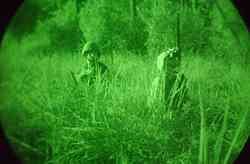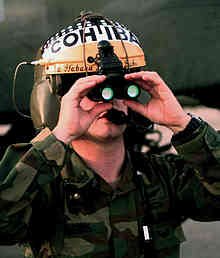Night Vision

Night Vision is a device that can be seen in a little light (or in the dark of the night). Regardless of any use of biological or technical, Night Vision is composed by two perspectives. One is the spectrum range and another adequate intensity. There is no capillary lucidum in people's eyes, so humans have less power to watch over night than many animals.
Spectrum (spectral) limit
The technique of night-fading spectral limit can be used to observe various objects in an invisible state of observation of humans. The human eye is limited to a small part of the electromagnetic spectrum called visible light. Increased spectrum gives the viewer the ability to observe the non-visible source of electromagnetic radiation. (Such as near infrared or ultraviolet radiation). Some animals, such as mantris shrimp, may use more infrared or ultraviolet spectrum than humans.
Heavy Limit
The necessary intense sight is the ability to see very little light.
There are comparatively good visas in the night than in many animals.
Increased intense range is achieved by using a picture enhancement, CCD, or photodetectors or other very low sound and high sensitive array through technical means.
History
Prior to introducing image enhancement technology, Night Goggles was the only way to watch at night, and thus it is widely used, especially in the ocean. In the era of World War II, the diameter of the glasses used in the night was generally 56 mm or more, seven or eight times better to see. The night's glasses are the most vulnerable to their large size and weight.
Current technology

source
A Night Vision Device (NVD) is an instrument that is made up of an intenselining of an image intensity tube, usually used by the military. Recently, the use of night vision technology is widely available for civilian use. For example, the Advanced Vision (EVS) helps the pilot to provide situational awareness and avoiding accidents for the aircraft. These systems are included in Cyrus and Cesana packages from the latest packages. The US Navy starts launching a variety of coordinates in a helmet-mounted display produced by the Elbit system.
A specific type of NVD, Night View Glowball (NVG) is a night vision device with a dial IPSIS. The device may send an enlargement pole to both eyes, or a separate image for each eye. The Goggles Night Vision, combined with the Night Vision Magnification Lens, has two eyes vision. Among other types, there are night vision devices that are stuck with only an IPS that can be installed in different places at night by firearms. NVG and EVS technology are becoming more popular with helicopter operations to improve technology security. NTSB is considering EVS as a recommended tool for security features.
Night glass is a single or bilateral with a large diameter. Large lenses can be combined and concentrated on the light, thus intensifying the light by purely optical means and enables the user to look alone in the dark compared to naked eyes. Most nightglasses have 7 mm or more spaces which combine light into the eyes of the user. However, many people can not use this facility because of their limited eyesight. To avoid this, the troops sometimes deliver entropy eye drop students.
Knight Vision system can also be installed in vehicles. Nightmares in an automobile improve the car's driver's abilities and are used to look away in dark or bad weather. Such systems usually use infrared cameras, sometimes combined with an active illumination strategy, then the data is collected and the driver is displayed. Such systems are currently offered as optional equipment on certain premium cars.